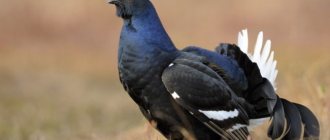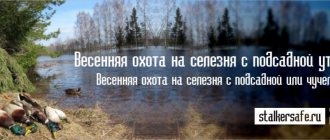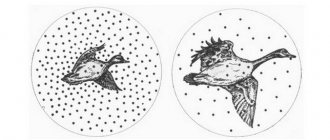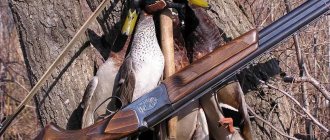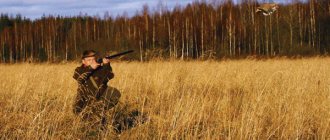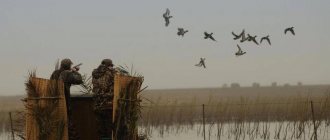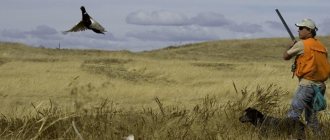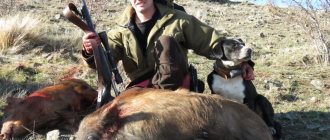Everyone has probably heard fascinating stories about hunting and fishing from friends who are looking forward to the opening of the season. Do you also want to join the hunting community and go duck hunting, but don’t know where to start? Then you have come to the right page, where current issues are discussed: how to hunt ducks, how to shoot correctly, what kind of bait and shot is needed.
General hunting rules
The period during which it is permitted to hunt waterfowl is long. Conventionally, it can be divided into 2 halves, for each it is necessary to take into account the nuances. In addition, the hunter needs to practice shooting in advance, study the features of shooting at a moving object, the rules of camouflage, and some legal requirements.
In order not to make a mistake and enjoy the hunting process, you need to prepare for the process in advance: pick up a weapon, accompanying equipment, camouflage clothing, bait. Also, do not forget to obtain a license-permit to hunt animals and birds.
Many hunters spend years accumulating knowledge about hunting, recording observations in hunting notebooks, and proudly sharing time-tested notes. Beginners just have to study them carefully and successfully apply them in practice.
Types of duck hunting
When going hunting in one place or another, we study the features of nature: the presence of a reservoir, the ability to hide in dense bushes or behind trees. But no less attention is paid to the method. Each of them is good and has its followers.
With stuffed animals
The duck is a flock animal, and therefore, when it sees a stuffed animal, it rushes towards it. For duck hunting to be successful, you need to choose a high-quality stuffed animal that will create an imitation of a bird sitting on the water. Hunting ducks with stuffed animals is good on reservoirs where there are no high thickets, and a bird flying from above can see it and join.
More often, plastic or rubber stuffed animals are found on sale. You will need about 10–20 of them. The flock is evenly distributed over the surface so that everything looks as natural as possible.
Note! Do not place products close to each other. The bird gathered in a dense group, most often frightened, is preparing for a rapid takeoff. This may alert potential prey. There should be about 1 meter between the stuffed animals, and in order to control the “flock”, they are tied with fishing line into a single whole.
From the approach
If you are heading outdoors with a small group in late autumn, then you will like this option. At this time of year, birds are on alert, ready to take off at the slightest danger.
A group of people is divided into two parts: the task of the first half will be to scare the bird away and make it fly, and the second half will wait for the bird in the sky and shoot.
With this type of hunting, you need to choose a convenient place: in places with dense vegetation it will be difficult for the hunter to move, and dense reed thickets will become a serious obstacle on the way to the shot bird.
On flights
Before heading to warmer climes for the winter, ducks make short flights several times from their feeding area to resting. More often this happens in the morning and evening dawn.
The main task is to accurately determine the route of movement, choose a convenient place, and wait for prey, hiding in the bushes. Try to be as quiet as possible and not make sudden movements, because birds are vigilant and react sharply to any noise.
Wait until the ducks are at a comfortable distance: shoot at the prey flying from above, or after it. To hone your skills, you can practice on a moving target.
With decoy
Duck decoy is an old invention that attracts ducks to a chosen place with its sound. This sound instrument is very similar to the quack of a living bird, but it is still better for a beginner to practice in advance, because maximum similarity can be achieved only after long training.
To do this, they make several loud sounds, after which they pause. If the gray duck does not respond and does not fly, repeat the procedure, but do not overdo it.
Note! Excessive consumption of semolina will only alert potential prey.
For selection, you can be guided by several criteria:
- Number of reeds. Single-tongued products are quite loud, but will only sound believable in the hands of an experienced hunter. Beginners are recommended to buy double-tongue ones. They are more believable, but quieter. They are best used in a small area.
- Material. Wooden ones sound softer, more truthful, but do not last long. Often they are made by avid hunters with their own hands. Acrylic ones will last longer, but cost more. They are characterized by a low, sharp, piercing cry, heard over long distances. Polycarbonate is an intermediate option.
- Electronic duck decoy. The most effective whistle that produces believable sounds. However, the use of an electric hook is prohibited by law and is considered poaching. Along with them, a thermal imager and long-length camera will help determine the position of a dishonest hunter.
With a decoy
Females are best suited as decoy ducks. She should have a loud, slightly hoarse voice. Outwardly, it should look like a wild one, not shy, and quite active.
It is best to use 2 ducks and position them in such a way that they cannot see each other, but can hear each other. By quacking among themselves, they will attract wild ducks. Drakes often come to their cry.
The decoy method, like all others, requires some preparation. Before hunting, the decoy duck must be trained to stay in the pond for a long time. Having tied the bait by the paw through a cord to a peg, the hunter hides in the bushes or thickets. From its point the entire surface of the water should be clearly visible.
With dogs
A dog is a faithful hunting companion. She will find a stricken duck, pick it up, and bring it to its owner. In addition, there is a high chance of finding someone else’s lost game and catching a wounded animal. One dog is enough for a whole group of hunters.
But in order to avoid mistakes and to avoid injuring the dog, it is recommended to remove the collar before starting. Otherwise, it may get caught on a bush or snag, which will injure the dog and disrupt the planned course of the hunt.
The most suitable dog breeds for hunting include:
- The spaniel is a small dog with excellent sense of smell and speed. Training a spaniel will not take much time. Without a single problem, they overcome obstacles in the form of dense thickets of reeds and reeds, and find wounded animals and killed game even in the water. Having found a living bird, they lift it on the wing, and with proper training they can jump out of the bushes, showing the owner the way.
- A pointer dog is an excellent companion for the upcoming hunt, despite all the difficulties of upbringing, training, and preparation for hunting waterfowl. It is better to choose an animal with short, hard hair such as a drathaar or shorthaired pointer to search for birds in the thickets.
- Laika is a fast, agile dog that happily dives into the water for game and tracks potential prey in dense reed or reed thickets. A short, but quite loud bark allows you to signal the owner that game is found. Dense, thick wool allows you to take this companion with you until late autumn. They are easy to train and will be happy to keep company for catching birds or other animals.
- With some training, good results can be achieved with other breeds of hunting dogs. The greatest ability and desire are demonstrated by dachshunds, setters, labradors, and fox terriers.
From the boat
This method is attractive to many hunters because it allows them to get close to a flock of ducks and aim accurately. However, at the same time it requires dexterity, endurance, and patience. You will have to not only monitor the prey, but also control the boat. There are 2 methods:
- From the entrance it is more convenient to fish on a river with a weak current, with dense reed thickets. Flat-bottomed shuttle or rubber boats are most often used. You should be very careful with the latter, as there is a high risk of getting caught on a sharp snag.
- A hiding place for hunting is a good option for a small lake without a current, with dense thickets along the shore, where there is an opportunity to hide. Recently, mirror ambushes have become popular, which recreate the picture of natural nature.
Hunting from a boat requires following the following rules:
- If you are traveling with a friendly group, it is important to remain quiet. The human voice scares game more than gunshots.
- Carefully hide the boat using a cover or camouflage net.
- Avoid splashing with the oars.
- Approach the prey from the leeward side, as the duck heads into the wind when taking off. This will allow you to get as close to it as possible.
- In the morning, position yourself on the sunrise side so that the sun dazzles your eyes and the game does not notice the boat.
- If you notice movement in the bushes, you should not shoot if the bushes are poorly visible.
- Shooting at ducks close to the shore is prohibited, as there is a high risk of injuring a person (the length of the shot is 100–150 m).
Spring hunting with a decoy duck
Hunting with decoy ducks requires the participation of special domesticated ducks - mallards (circular ducks). Their preparation is a special art that requires a lot of effort and time from the hunter. Often, preparing a mallard takes more than one year.
The main positive quality of the ring-tailed duck is its real voice, with the help of which the bird lures its wild fellows towards it. However, the cry of a domestic duck is significantly different from the cry of a wild bird. Therefore, some hunters specifically cross domestic ducks and wild mallards - this allows them to give the bird a deep voice and special short calls, that is, rapid calling calls. Ducks bred by crossing are rarely suitable for hunting even in the first generation. Only the second or third generation acquires the necessary timbre of voice and short calling sounds.
During a hunt, a decoy duck is left in the place where they want to lure the drake. To do this, at a distance of no more than 20 meters from the hunting shelter, a wooden peg is driven into the bottom of the reservoir, the upper end of which contains a swivel - a special fastening that is tied to the duck’s leg and does not allow it to swim far. The swivel constantly rotates around the peg, so when the duck swims in circles, it does not wrap the rope around it and does not get entangled. It is useful to leave a couple of logs or boards near the mallard, on which she could rest.
If a decoy duck does not attract drakes for a long time, it is helped with a decoy. If the drake has already noticed the duck, then you should not continue to use the decoy - this will scare him away as soon as he senses the substitution.
Permitted duck breeds for hunting
In Russia it is officially allowed to hunt 6 species of wild waterfowl:
- Mallard is the most common species. Males grow up to 60 cm in length, have an emerald-pearl color of the head and neck, which is separated from the rest of the body by a white rim. Females of borax reach 50 cm in length. Habitat: swampy ponds, reed thickets.
- Teal is a group of birds whose body length ranges from 30 to 40 cm. Males have a brighter color compared to females, but in the spring they become paler and more inconspicuous. A thin green stripe runs parallel to the eye line. The easiest time to spot them is during the mating season, when the males fly high above the female.
- Wigeon is a difficult catch, suitable only for a gambling person. Representatives of this breed fly quickly and behave very carefully. The easiest time to catch them is at the end of October - the birds are preparing for migration and wintering, and lose their vigilance. The color is light, the head is a bright brick color.
- Pintail is another fairly common species. Adults reach 55–65 cm in length and weigh more than 1 kg. They have a thin neck, and on a small head there is a gray beak with a characteristic blue tint. The tail is slightly pointed towards the end. This is a lazy, noisy bird.
- Shovelers grow up to 50 cm in length and weigh 1 kg. They have a wide beak and a flattened shape. Females are greenish-brown, while males are bright black.
- The gray duck is similar to the mallard or pintail. They have the same faded, nondescript plumage and can only be distinguished in flight. This breed has a white mirror with a bright chestnut spot in the middle. The beak is dark gray, the iris is brown, and the legs are yellow.
Seasonal features
There are two duck hunting seasons: spring and summer-autumn, but due to the climate in different regions of the country they begin at different times. Therefore, when going hunting, it is necessary to rely on the regulations of local authorities.
Spring
With the onset of warm weather, the bird is more often found in swampy ponds and lakes overgrown with thick grass. At this time of year it is prohibited to shoot in the air, as there is a high risk of confusing females and males. Also, dense thickets that impair visibility can become a significant obstacle when hunting ducks in spring.
In the spring, experienced hunters often use decoy birds, decoys or duck decoys. Sometimes several methods are combined: for example, decoying a duck and decoying a bird. More often, mallards, shovelers, and pintails come to decoy ducks.
You can use special small tents or dense thickets as shelter. It is important to prepare in advance so that the bird perceives the new object as natural.
Summer
The warmest time of the year is characterized by the greatest success. Rarely does a shooter return home empty-handed. In summer it is easy to hide, which increases the chance of getting within shooting distance of the prey.
Duck hunting begins in August in almost every region. More often they hunt from the entrance or from the entrance. In the evening, there is a greater chance of success if you know feeding and resting places.
Autumn
With the onset of cold weather, the bird prepares for seasonal migration. At the same time, they migrate gradually until the water bodies begin to freeze. Gathering in a flock, they fly to their sleeping place, and in the morning they again go to the selected lake or river for feeding.
Note! To have successful fall duck hunting, it is important to know both of these locations. It is in the fall that you can use all methods of hunting birds.
When to go
To determine the exact period when hunting is allowed, you need to carefully monitor messages from services for the protection and use of wildlife. For each region, the beginning and end of the season are determined individually.
Regarding the time of day, choose early morning or evening, when the flock goes to feed and then rest.
Where to go
It can be difficult for beginners to identify good “rich” places, so more often they join groups of professionals, ask local residents, or look for places close to their dacha or favorite tourist center.
Others get information on the Internet, where maps of hunting areas are posted. Additionally, study the satellite map of the area to have a complete picture of the area where your hunting spot will be. Even simple observation and intuition will help you find the treasured trophy.
Water
A duck will not swim in every lake. A solid shore with easy access and clear water are loved by many people, but not by ducks. For her, the ideal habitat is considered to be small, smelly lakes and ponds, overgrown with dense thickets of reeds or reeds along the shore and snags, where she can hide from predators.
The bird gets food from the muddy bottom, overgrown with algae and reeds. On topographic maps such places are often designated as swamps.
Hunting dog on a duck hunt
The dog helps to scare away birds and is a reliable assistant in the process of searching for a downed bird. However, they must be prepared and trained in advance.
Most of all, hunters value spaniels, which easily make their way through dense thickets, and Labradors, which retrieve ducks from icy water. Also widely used are hardy pointers (kurtshaars and drathaars), capable of hunting all day long.
Opinions about mongrels are divided: some believe that such dogs are irreplaceable after reaching 5–6 years of age, while others are convinced that they can only spoil the result.
Hunting with a dog
As a rule, this method of duck hunting in the fall is performed in exactly the same way as approach hunting. The only fundamental difference is that a person will receive invaluable help from his four-legged companion. A well-trained hunting dog is capable of not only catching wild birds in the air, but also bringing back fallen prey at the command of its owner. Cops have an excellent sense of smell, so it will not be difficult for them to find a dead duck. Some dog breeds will even retrieve it from the water. Thanks to this, the hunter does not have to take into account inertia when shooting.
What breeds of dogs are there for duck hunting? Perhaps spaniels are best suited for this task. Dogs of this breed not only have a keen sense of smell and excellent hunting abilities, but also a first-class understanding of their owner. Spaniels are easy to train, so you shouldn't have any problems training them. These dogs are excellent swimmers, so you don’t have to worry about not being able to find wounded animals in the water. Plus, dogs get along well with children, which allows you to keep your pet in your apartment, and not in an enclosure, like other hunting dogs.
Preparing for a duck hunt
The preparatory stage is one of the most important. It includes:
- selection of equipment, disguises and weapons;
- studying the features of the terrain and relief, hiding places for duck hunting;
- familiarization with duck breeds, their habitats and differences in behavior;
- compliance with legislation regarding the beginning and end of the season, rare breeds of birds listed in the Red Book (for example, the coot duck).
You also need to improve your shooting skills.
Clothing and equipment
The key to success is having the right clothing and equipment for duck hunting. First of all, take care of anti-water equipment - boots, waders for shallow lakes in order to get closer to the prey. An inflatable boat for hunting will be needed to collect prey, but not everyone will like to shoot from it.
A bandolier is not always useful. Many avid hunters are more accustomed to taking cartridges out of a large pocket or bag, where they lie in bulk.
The color of the clothes is close to natural. It is better to choose a jacket of a gray-brown or greenish tint, summer camouflage. In terms of density, seasonality should be taken into account: the suit should be warm and comfortable, and in the summer heat, something light and neutral in color should be worn under the jacket.
When it's hot, also consider wearing a hat and mosquito repellent. The color of the trousers is not important, as they are often hidden by waders. Choose a short jacket so as not to wet the floors in water.
What weapon to use
Duck hunting involves the use of smoothbore weapons. A shotgun for duck hunting must have a precise and sharp action. Most beginners and amateurs prefer double-barreled shotguns with over-and-under barrels. Among them, IZH-27 or TOZ-34 are popular.
Among smooth-bore guns with horizontal barrels, IZH-54, IZH-58, and IZH-43 are widely used.
For professionals who are able to catch a bird with the first shot, we can recommend IZH-18. Semi-automatic weapons (MC-21-12, MP-153, MP-155) are gaining popularity.
What to look for when choosing stuffed animals
Experienced hunters claim that stuffed animals contribute to the successful outcome of the planned event. Many breeds of ducks “peck” on them. But it is important to pay attention to quality.
They are divided into domestic and imported. Being a lover of Russian-made products, a detailed description can be found on hunting forums and websites. They are cheaper than their foreign counterparts and sometimes do not differ in quality.
If you are financially unlimited, then German and Italian stuffed animals are available. They float well on the water, do not lose their original shape and prove their effectiveness for many years.
What to look for when purchasing:
- The product should not glare from the sun's rays, and drizzle should not accumulate on the surface and dew should not form in the morning. You can ask the seller about these common “diseases” or read the information on a hunting forum, otherwise a low-quality product will scare away a wary bird.
- Full-size stuffed animals made of foam, plastic and other materials that cannot be folded will create a problem during transportation. A large artificial flock is more likely to attract game. It is better to choose rubber or collapsible ones that can be placed in a bag for stuffed animals.
Legal registration
If you do not have a state hunting license and license (permit), then it is time to deal with the legal issues of preparation. To do this, you need to contact the territorial Department of Hunting and Fishing.
Here you can also find out about the nearest places for hunting - publicly accessible hunting areas (PDOU). It should be noted that rare huntsmen will offer comfortable conditions. Beds in a dilapidated house, a boat for rent and a sauna for relaxation may be available.
If you are not used to such harsh conditions, then there is the opportunity to buy a ticket to hunting grounds assigned to hunting users.
Note! However, the trip will cost an order of magnitude more.
You can find out which category the selected location belongs to through the department, the State Services portal and the geoportal. If there is no information about the reservoir anywhere, then most likely it is private.
Ammo type
During zeroing at the shooting range, they choose which cartridges are best for shooting a duck.
Duck shot number
For ducks, they often buy factory hunting cartridges or use self-loading ones. The fraction number is determined depending on the season:
| Breed | Duck shot number | ||
| Spring | Summer | Autumn | |
| Scoter, blue scoter, shelduck, red duck, merganser | 2–3 | 3–4 | 2–3 |
| Mallard, gadwall, pintail, wigeon, goldeneye, red-headed and white-eyed duck | 3–4 | 4–5 | 3–4 |
| Lutok, shoveler, teal, whistling teal | 5 | 6 | 5 |
Container
For factory cartridges, a plastic container is used as a wad, into which a certain amount of shot is placed. This species has improved combat accuracy. This fact is explained by the fact that during the shot the charge is protected from the risk of deformation.
Containerless
The cartridges do not have a container. This is a kind of classic for experienced hunters.
Ammo for wounded animals
In order not to miss the wounded animal, you must use cartridges with increased accuracy and sharp fire. You must act quickly and harmoniously, because it is prohibited to leave a wounded animal while hunting.
Weighing shot and gunpowder
When preparing for a duck hunt, it is important to consider distance and shot selection. For a rifle familiar to many hunters, the weight of which does not exceed 3 kg, you need 12 gauge cartridges and 34 grams of No. 5 shot. In this case, you cannot ignore the instructions from the manufacturer, since the criteria can sometimes change.
Requirements for sleeves
You should not buy a large number of cartridges for future use. It is better to buy them for 1 year, with the expectation of full use.
Attention! When purchasing, pay attention to the absence of external damage and defects.
Plastic options are popular: they will not get wet or swell under high humidity, unlike the paper version.
Hunting methods
Hunting methods vary. There is: from a boat;
- from the shore;
- chassis;
- with a dog;
- with stuffed animals;
- with semolina;
- with a decoy;
- on flights.
With stuffed animals
Hunting with stuffed animals is a fairly common method, especially nowadays. The stuffed animals are seated at a distance of at least 2-3 body lengths from each other - this is how the ducks are positioned when everything around is calm.
The hunter camouflages himself in a hidden area and waits until a flying flock, having noticed the scarecrows, goes down to the water to feed. Usually this is a morning hunt.
From the approach
Approach hunting requires more skill. The hunter must find the ducks hiding there in the thickets of reeds or grass, approach them at close range, scare them away, and shoot them in mid-air. To return with prey, you need to know about places where the desired game can hide, be able to walk a lot and quietly, camouflage well and shoot accurately.
With decoy
A duck call imitates the cry of a duck, so flying flocks, hearing it, descend onto the water. However, you also need to be able to work with a decoy. Before hunting, novice decoys must learn the “duck alphabet”, breathe correctly and decoy.
When hunting, you should not “quack” all the time. The simplest and most uncomplicated call is short, loud, and at regular intervals.
With a decoy
As the name implies, a decoy duck will lure prey. She, unlike silent stuffed animals, quacks, thereby attracting wild relatives.
Remember! Drakes that land on a decoy should be shot so as not to hit your duck.
The decoy should have a loud, clear voice and a color that should closely resemble its wild relatives. The method works great with two decoys that are planted so that they cannot see each other. However, they hear, and therefore actively “talk.” The bait is “tied” in shallow water so that it does not float away far.
From the boat
When walking hunting is not possible, a boat is used. Hunting from a boat requires the following skills:
- silently steer the boat using oars and a pole;
- searching for ducks;
- accurate shooting, despite unfavorable conditions.
Usually there are two people hunting from a boat: one controls, the other stands ready with a gun. You should move against the wind. It is very important to remember about safety precautions in order to avoid accidents or “swimming” in a pond. Moreover, after such water procedures the gun will be lost.
How to aim correctly
An accurate shot is the key to the success of every hunt. Many become familiar with the errors in the process and correct them. However, failures, misses and unsuccessful shooting are not fun.
To avoid most common mistakes, you need to learn the aiming system, which guarantees you will return home with the long-awaited trophy.
Flying duck hunting rules
Before you shoot a duck, you need to learn how to determine the distance to potential prey. The size of the gap when aiming largely depends on this.
It will be easier for beginners to navigate in clear sunny weather, when the viewing range is not distorted by fog or raindrops. Duck hunting in the rain requires more preparation and experience.
A duck in flight involves using one of 2 techniques:
- With a stationary gun, that is, a person directs his weapon to a point along the bird’s flight path, and as he approaches the target, he pulls the trigger, taking into account the lead.
- With a leash, that is, at the moment of the shot, the gun continues to move along the flight path of the game. In this case, the gun moves along with the shooter’s body.
Sighting a flying duck with a leash requires following simple rules:
- If the duck in flight is aimed at the hunter, then the leash is accelerated and the lead is reduced.
- Prey flying by the side forces you to slow down the leash and increase the lead step. If the target is 40 meters away from you, then the lead can be 1.5 meters. In such a situation, many run the risk of involuntarily stopping the gun, so it is better to start the leash from behind the bird, gradually overtaking it. So, the sight will be more accurate.
- A low-flying bird with a bayonet requires a slow leash. Sometimes it’s better to let her through and hijack her.
Rules for hunting sitting or swimming ducks
If a duck is swimming, then you need to aim slightly below its body. That is, the shooter creates an imaginary line from the visible point of contact with the water surface.
If the duck is motionless on the shore, then the point of the shot will be the middle of its body. In the fall, when the fat layer has accumulated, it is not recommended to aim at the chest. The bird will most likely only be wounded and will be able to escape. In the spring, there are no exact criteria for sighting a sitting duck.
Where to stand
Ducks often hide in dense thickets or reeds in a pond. Much less often in the thickets of a meadow, where it can land comfortably. These birds prefer to avoid high banks and dense forests. Therefore, it is better for the shooter to look for 2 small ponds where ducks live, and stand on the bridge between them.
This will give you the greatest view of attractive places for ducks. Many people look for small toes leading to reaches, but if they can’t find such places, then the usual boundaries of open water and supports will do.
Ideally, you can print out a satellite map that will tell you about the bird's possible escape routes to nearby bodies of water. This will allow you to calculate the flight path and block it.
How to stand
The hunter must be quiet and remain motionless for a long time so as not to scare away the prey. Only the head moves, looking for a potential victim. It is better to choose places where grass and vegetation will cover you to the waist.
Listen to every sound. These could be shots that scare the flock in your direction or the characteristic sound of the flapping wings of approaching prey.
Attention! Don't focus your attention on far-flying flocks, otherwise you risk missing a nearby duck.
Whom to shoot
Choose one goal for yourself and strictly follow it. Remember, if you chase two birds with one stone, you risk being left with nothing. A duck is quite easy to identify: it has a short beak, a long neck growing from a dense, massive body.
When determining a breed, you should largely rely on the color of the plumage. If the prey cannot be seen, it means it is flying far away and the shooter risks shooting a rare protected animal.
How to shoot
The easiest way is to shoot an approaching duck, crossing out its flight path. A stolen duck often becomes an elusive target, even if it has been wounded. She is more likely to escape from the shooter and it will be difficult to finish her off.
You have to prepare yourself for the fact that there is one shot per bird. The killed bird will be carried away by inertia approximately at a distance equal to its flight altitude, multiplied by two. This should be taken into account when choosing a place, so that later there will be no problems with finding prey or wounded animals.
Choosing a time and place to hunt
First you need to find the place where the game is based. Ducks usually choose overflowing ponds, lakes, and small overgrown swamps. Here you need to find an open place on the water where it will be convenient to place a decoy duck or stuffed animals so that they are visible to both flying drakes and the hunter from the hide. There should be no thickets of bushes, reeds or other vegetation nearby that a duck could catch on with its boot.
The hut or hide is installed at a distance of 20-25 meters from the site where game is expected to appear. It is necessary to install the shelter in advance, before the summer of duck flocks.
Choose a clear day for hunting; in cloudy weather, the drake can circle all day and never land on the water. The best time is early morning or evening, when the first stars begin to appear. During these hours, birds are much more active than during the day.
